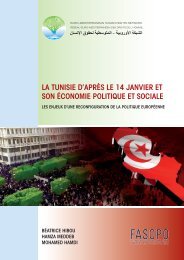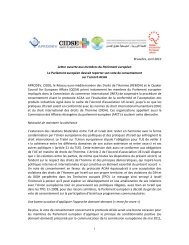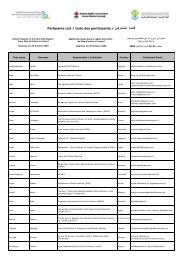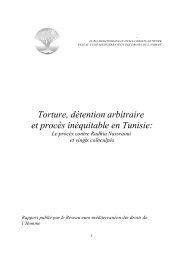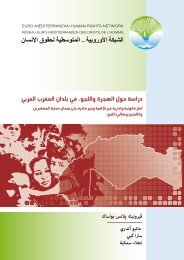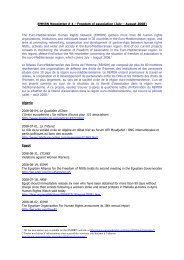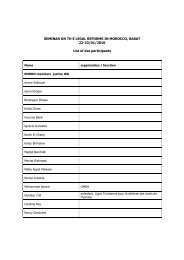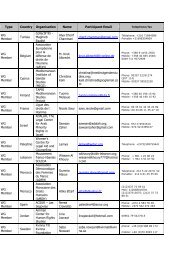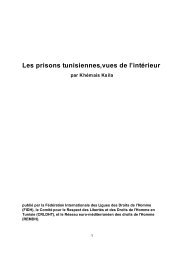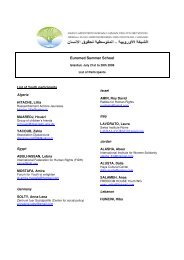tunisia after 14 january and its social and political economy - Refworld
tunisia after 14 january and its social and political economy - Refworld
tunisia after 14 january and its social and political economy - Refworld
Create successful ePaper yourself
Turn your PDF publications into a flip-book with our unique Google optimized e-Paper software.
as well as in Tunis. In addition, Tunisia has achieved the status of first destination for Europeanpatients (18% of all patients) who wish to take advantage of cosmetic surgery operations thatare less expensive than in Europe. In this regard, several agencies have specialised in this type ofmedical tourism, turning Tunisia into a ‘paradise for the scalpel’. 56 Faced with the developmentof this sector, the Tunisian authorities took over responsibility for it in 2008, <strong>and</strong> actually decidedto support this activity so as to turn Tunisia into a country that exports medical services by 2016.These hospital centres are situated in Greater Tunis <strong>and</strong> on the coast. Hospitals in the interior ofthe country lack human <strong>and</strong> material resources, <strong>and</strong> simply pick up second-h<strong>and</strong> equipmentused by hospitals in the coastal zones. But even the sectors targeted by government programshave remained characterised by imbalances to the detriment of regions in the west, thecentre <strong>and</strong> part of the south: the road network remains based on Tunis <strong>and</strong> the coast; themerch<strong>and</strong>izing of public services (clean water, health, education) aggravates the disparities. 57The division of entrepreneurial activities between the regions is also highly unequal, <strong>and</strong> therelative proportions leave no doubt as to the inequalities in the number of jobs available.Whereas there is one enterprise for every twenty members of the working population in the Eastof the country, this figure comes down to just one enterprise for every 170 workers in the West.These data reveal something that is obvious for anyone who knows Tunisia: a concentrationof enterprises in the regions of Greater Tunisia <strong>and</strong> the coastal regions. They also explain therural exodus of active populations from the interior of the country to <strong>its</strong> only dynamic region.The crisis in the agricultural sector provides us with another explanation for the extent ofinequalities between regions. The rural world has historically borne a considerable burden inthe transformations of the Tunisian <strong>economy</strong>, firstly in the modernising of the <strong>economy</strong>, then inthe preservation of an economic <strong>and</strong> <strong>social</strong> balance through the fixing of agricultural priceswithout the sector benefiting from the aid <strong>and</strong> subsidies that might have kick-started <strong>its</strong> ownmodernisation. If we are to believe the official data, this sector, representing 13% of the GDP, <strong>and</strong>employing 16% of the active population in 2007, has been declining for at least two decades. 58For the period 1989-2003, the average increase in agricultural added value was lower thanfor the rest of the <strong>economy</strong>: 3.7% for agriculture as opposed to 4.7% for the <strong>economy</strong> as awhole. In addition, liberalisation <strong>and</strong> the withdrawal of the state over the last two decades havelargely contributed to increasing the difficulties experienced in the rural world. The rural exodusof young men led to the agricultural population becoming more older <strong>and</strong> more feminine(the average age was 53 in 1995); this trend has continued, <strong>and</strong> the inequality between themajority of small- <strong>and</strong> medium-scale farmers using a family labour force on the one h<strong>and</strong>, <strong>and</strong>big farmers on the other, has widened. This displacement of the population – masculine for themost part – to the big industrial zones of Greater Tunis or the Sahel is part of the formation ofa reservoir labour force on which industrial entrepreneurs draw. This reinforces the latter in their4056 ‘Au paradis du bistouri’, www.doctissimo.fr, accessed on 7.5.2011.57 Bruno Romagny <strong>and</strong> Christophe Cudennec, ‘Gestion de l’eau en milieu aride: considérations physiqueset <strong>social</strong>es pour l’identification des territoires pertinents dans le Sud-Est tunisien’, Développement durableet territoires (online), Dossier 6: ‘Les territoires de l’eau’, uploaded on 10 February 2006 (accessed on 16April 2011). URL : http://developpementdurable.revues.org/1805.58 The agricultural sector provided 46% of jobs in 1960 but just 23% in 1995-2000 <strong>and</strong> 16% currently. SeeJean-François Richard, ‘Le devenir de l’agriculture tunisienne face à la libéralisation des échanges’,Afrique contemporaine, n° 219, 2006/3, pp. 29-42.



